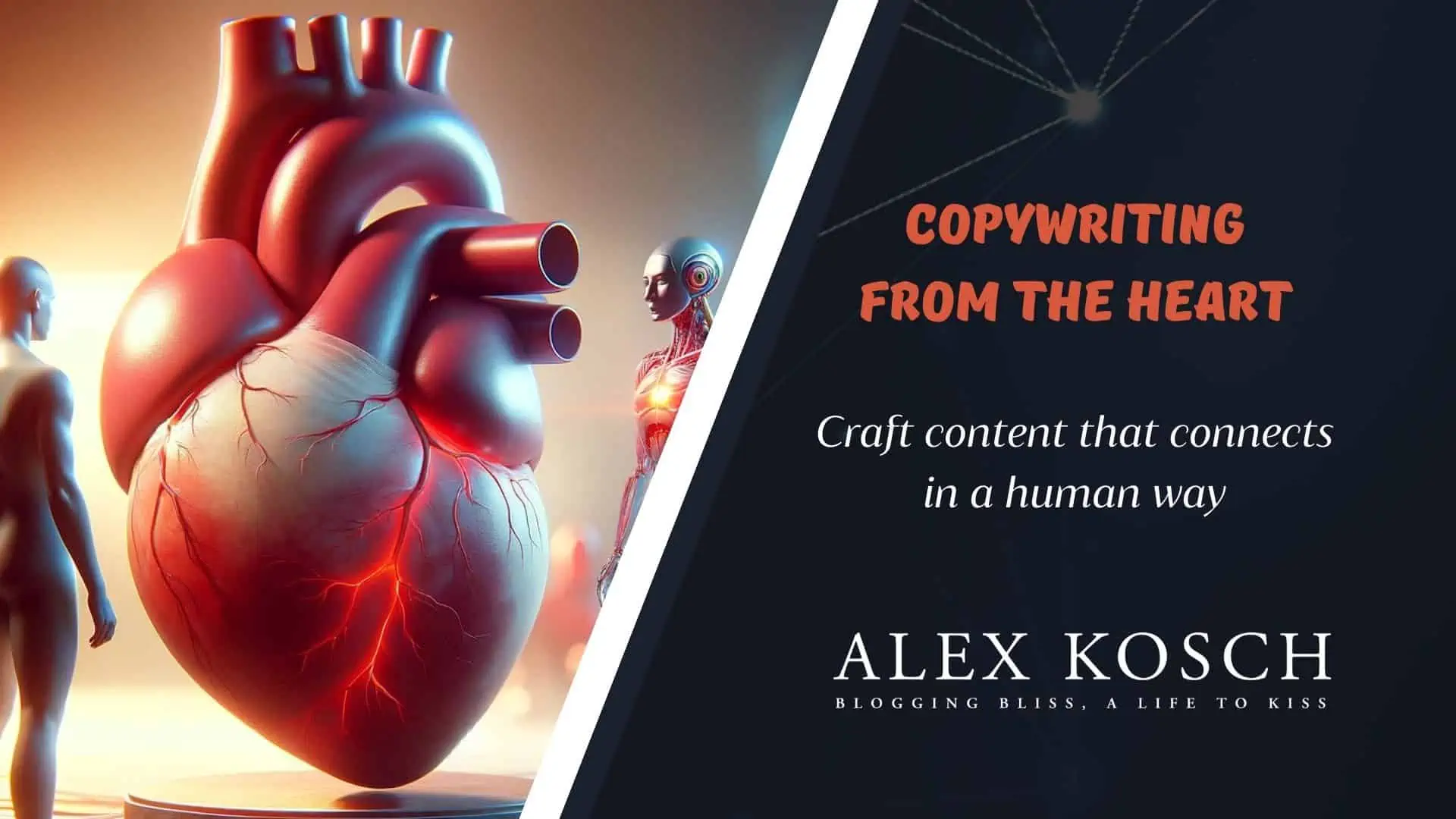
Ugh, I know, right? It’s pretty lame when content has no soul or personality behind it. Like reading those robotic texts spit out by ChatGPT — we get it, you can rank in search, but damn, those things are dry as dust!
Ok, enough whining. Time for solutions!
I’m Alex Kosch, and I want to show you a better way to pump some life into your content. Give it an actual beating heart!
See, I kinda stumbled into this whole AI copywriting scene when I started my blog. But today, I’ve got a sweet gift for you — the HEART copywriting framework.
Use it yourself when writing manually or with AI tools. Either way, it’ll help your content feel more human. More you!
No more stalling; let’s dive right into the good stuff! Here’s how HEART copywriting works…
HEART stands for:
As you can tell from the acronym, it’s all about appealing to your audience on a deeper level.
Some people might say this approach is too “touchy-feely” or manipulative. But I think when done right, it can create copy that resonates at the core of what it means to be human.
In this guide, I’ll break down each element of the HEART framework and show you how to implement it in your copywriting. You’ll learn techniques to:
- Tap into your audience’s deepest hopes and dreams
- Trigger powerful emotions that drive action
- Align your brand with their highest aspirations
- Form authentic relationships that foster loyalty
- Paint a vivid picture of the transformation your product can provide
If you want to connect with customers in a more meaningful way, the HEART framework is worth exploring. Let’s do it!
Why HEART Copywriting Matters
We live in the information age. Your audience is constantly bombarded with ads and content vying for their attention.
To stand out, you need copywriting that cuts through the noise.
Many brands focus only on highlighting features and benefits. But this type of self-centered copy fails to resonate emotionally.
HEART copywriting takes the opposite approach. It puts your audience’s deepest hopes, dreams and desires first.
When you align your copy with what your audience truly cares about, you form a powerful connection. This builds the know, like and trust that drives sales.
As legendary copywriter Eugene Schwartz once said:
“The purpose of a copywriter’s work is to cause the reader to act in the interest of the client, not the copywriter.”
In other words, effective copy is always audience-focused, not ego-focused.
The HEART framework builds on this principle. It provides a model for creating copy that sparks an emotional response in your reader.
Let’s explore each element and how to apply it.
H — Tap Into Their Hopes
The “H” in HEART stands for hopes. To implement this strategy:
Step 1: Identify Your Audience’s Core Hopes
Your first mission is to uncover your audience’s biggest wishes, dreams and aspirations. Dig into reviews, testimonials, support conversations and social media:
- What outcomes are they hoping your product will provide?
- What problems do they want to solve in their life or business?
- What does success look like to them?
Look for common themes and desires. For a business owner, core hopes may include:
- Gaining more freedom and flexibility
- Building a legacy company
- Achieving financial security
Step 2: Weave These Hopes Subtly Into Your Copy
Next, work these hopes organically into your copy. But tread carefully — you don’t want to come across as manipulative.
Avoid being too direct or “salesy” here. Simply reflect back the outcomes your audience already desires, like freedom or legacy.
When you align your copy with their deepest hopes, it starts to resonate at an emotional level.
Step 3: Show How Your Product Fulfills These Hopes
Finally, provide a vision of how your product can turn these hopes into reality.
Describe how your offering can help them achieve the outcomes they truly desire — whether it’s freedom, security or something else. This builds powerful resonance.
When you tap into hopes in this authentic way, your copy starts to feel less like “marketing”. Instead, it’s a message human to human.
Let’s see some examples of activating hopes in copy:
Bad:
“Acme Accounting Software offers advanced reporting features to grow your business.”
This is focused on features, not the audience’s hopes.
Good:
“Do you hope to build a thriving business that stands the test of time? Acme Reporting Software provides the visibility you need to make strategic decisions — so you can grow the legacy company of your dreams.”
This subtly activates the audience’s hope of building a legacy business.
Bad:
“The Morgan Grant Method will help you get in shape fast.”
Focused on quick results, not deeper hopes.
Good:
“Imagine finally getting back the energy you need to keep up with your kids and live life to the fullest. The Morgan Grant Method equips you with a proven plan to get your health back on track.”
Aligns with hopes for health and family.
See the difference? Subtlety aligning your copy with your audience’s hopes creates a powerful emotional response.
Now let’s look at the next element…
E — Appeal to Their Emotions
The “E” in HEART stands for emotions. As Maya Angelou famously said:
“People will forget what you said, people will forget what you did, but people will never forget how you made them feel.”
To create copy that sticks, you need to make your audience feel something.
Some tips for activating emotions in your copy:
Tap Into Their Fears
Fear is a primal emotion and strong motivator. What painful outcomes does your audience fear?
- Are they afraid of losing their home or business?
- Do they fear becoming obsolete in their career?
- Are they anxious about being able to pay for their kids’ education?
Subtly activating these fears builds urgency to take action. But take care not to overdo it.
Spark Positive Emotions
Don’t just focus on negative emotions. Positive feelings like joy, pride and gratitude are also powerful motivators.
Use vivid language to paint a picture of how your product or service will make your audience feel — whether it’s confident, free, appreciated or respected. This creates an emotional hook.
Leverage the Element of Surprise
The unexpected also triggers strong emotion. Clever analogies, intriguing questions and surprising stats grab your reader’s interest.
Inject these elements to keep your copy lively and emotional. Just don’t go overboard — you don’t want to lose credibility.
Tell Compelling Stories
Stories bring copy to life in a vividly emotional way. Use anecdotes and case studies to show real transformation.
Stories of struggle and eventual triumph are extremely compelling. They build an emotional connection with the reader.
With a bit of creativity, you can infuse emotion into any type of copy. The key is to tap into feelings that already resonate with your audience.
When your copy appeals to emotion, it’s hard for readers to ignore.
Next let’s look at aligning with audience aspirations…
A — Align With Their Aspirations
The “A” in HEART stands for aspirations. Your audience has big dreams of who they want to become.
Maybe they aspire to be an industry leader, a top performer, or a role model for their children. These aspirations are powerful motivators.
To harness this in your copy:
Step 1: Identify Your Audience’s Professional and Personal Goals
Just like hopes, do research to uncover your audience’s biggest aspirations. Look for common themes like:
- Growth
- Achievement
- Respect
- Status
- Work-life balance
Their aspirations likely tie closely to their deeper hopes.
Step 2: Show How Your Offer Can Help Achieve These Goals
Next, craft copy that shows how your product or service assists with these aspirations.
For example, if your audience hopes to become an industry leader, showcase how your offering can boost their credibility and status.
When you align yourself as a partner in their growth and success, you create resonance.
Step 3: Use Aspirational Language and Visuals
Finally, infuse your copy with aspirational words and imagery. For example:
- “Join the top performers in your industry…”
- “Take your business to new heights…”
- “Step into the winner’s circle…”
This types of language taps into your audience’s vision of their highest self.
When crafted authentically, this technique forges an emotional bond with your readers. It shows you understand and relate to their deepest aspirations.
Let’s look at some examples:
Bad:
“Smith Consulting provides business coaching services.”
This is focused on features, not aspirations.
Good:
“Are you ready to step up as a leader in your industry? Smith Consulting partners with driven professionals to unlock their full potential.”
Aligns with aspiration to be an industry leader.
Bad:
“Get in shape with the 30-Day Slimdown Plan.”
Focused on a short-term goal, not deeper growth.
Good:
“This year, step into the best shape of your life. The 30-Day Slimdown Plan gives you the tools to become the healthy, energized person you aspire to be.”
Connects fitness with the aspiration for self-improvement.
See how subtly aligning with audience aspirations creates a more emotional hook?
Now let’s look at forging real relationships through copy…
R — Form Relationships
Relationships are the lifeblood of business. The “R” in HEART focuses on building real connections.
Today’s consumers see right through disingenuous marketing-speak. To resonate, your copy must reflect a genuine understanding of your audience.
Some tips for forging relationships through copy:
Adopt a Conversational Tone
Imagine you’re having a one-on-one talk with the reader. Avoid overly formal or stiff language.
Use natural phrasing and vocabulary your audience uses day-to-day. This informal tone helps form an authentic connection.
Ask Thought-Provoking Questions
Engage the reader by asking open-ended questions, like:
- “What’s your biggest challenge when it comes to __?”
- “Where do you see your business in the next 5 years?”
- “What’s standing in the way of you and your dreams?”
This stimulates thought and shows you want a real dialog.
Use Inclusive Language
Build rapport by using inclusive words like “you”, “we” and “us”. This embraces the reader as part of your in-group.
Avoid “me” and “I” language that feels selfish and distant. Focus on helpfulness, not salesmanship.
Share Your Origin Story
Personal stories help forge a human-to-human bond. Provide a glimpse into your company’s origin story:
- Why did you start this business?
- What challenge were you facing?
- How did you come up with the idea for your product?
These vulnerable insights help readers relate to you.
Spotlight Customer Stories
Social proof is powerful, but avoid generic testimonials. For authenticity, share real customer stories.
Bring readers into the conversation by having them explain in their own words how your product changed their life or business. This builds a personal connection.
Crafting copy that forms true relationships takes finesse. Avoid sounding robotic or distant. The payoff is a high-trust bond with your audience.
Next, let’s examine the final element: transformation.
T — Offer Transformation
The “T” in HEART represents transformation. At the end of the day, your audience seeks change and progress in their lives. They have goals they’re striving towards, problems they’re struggling with.
Your copy needs to show how your product can profoundly improve their situation.
Some tips for portraying transformation:
Describe the “After” First
Don’t start by explaining features and functions. Cut to the benefit by describing the amazing outcome you offer.
Paint a vivid before-and-after picture of the transformation. This creates desire by showing where your reader can go.
Share Dramatic Case Studies
Use compelling stories to make the transformation tangible:
- “Mary was ready to give up on her business until she started using [your product] — within 5 months revenue grew by 200%.”
- “After a health scare, Ryan used the [your product] system to lose 50 pounds and reverse his diabetes.”
These vivid examples help readers envision change.
Leverage the Power of Metaphor
Metaphors brilliantly illustrate transformation. For example:
“Acme Analytics is like having a Fortune 500 CFO in your corner.”
This quickly conveys the idea of gaining top-tier strategic advice.
Focus On Outcomes Over Features
Avoid copy that just touts what your product does. Instead focus on what it provides — how it tangibly improves lives.
For example, don’t say “AppValue analyzes your customer database.” Explain how it helps maximize retention so they can grow their business.
The core desire is transformation. When you show readers how your product fulfills this, it powerfully resonates.
Putting HEART Into Action: When and How To Apply This Framework
The HEART methodology clearly has power. But implementing it effectively requires finesse and strategic thinking.
In this section, I’ll share tangible tips on when and how to infuse HEART-based techniques into your copywriting.
We’ll look at specific examples of how to apply this copywriting framework to:
Let’s dive in!
Website Copy: High-Priority Pages
Your website is a crucial touchpoint for establishing emotional connections with customers. But where specifically should you focus your HEART copywriting efforts?
Homepage
Your homepage needs to quickly communicate what you stand for. Infuse your value proposition and branding with subtle references to your audience’s aspirations and desires.
For example, a financial advisor’s homepage headline could state:
“Helping Families Build Legacies of Financial Freedom.”
This instantly taps into HEART elements of hopes, aspirations and transformation.
Service Pages
On your core services pages, blend features with emotional outcomes. For instance, a child therapist’s services page could say:
“Our trauma-informed therapy approach helps your child rediscover their confidence, resilience and joy.”
Notice how this highlights not just the method, but the deeper transformation result.
About Page
Your About page is the perfect place to share your origin story and values. Infusing HEART here helps visitors connect with the humans behind your brand.
For example, an eco-friendly product company could share how watching sea turtles suffocate from plastic pollution sparked their mission to create sustainable goods. This builds an emotional hook.
Testimonial Section
Feature vivid stories of real transformation provided by your product or service. For example:
“After her accident, Maria thought she may never walk again without chronic pain. But after working with [company], she’s now training for her first 5K race pain-free.”
This type of narrative activates hopes as well as illustrating dramatic change.
When crafting website copy, look for opportunities to weave in HEART elements — especially on pages dedicated to your purpose, services and proof.
Next, let’s examine how to apply this framework to emails…
Email Campaigns: Target Key Sequences
Email is intimate by nature — making it well-suited for HEART-based copy. But be strategic about which campaigns you invest your energy in.
Welcome Series
Make an emotional connection right off the bat in your onboarding emails. Share your origin story and infuse copy with their hopes for change.
For example, the first email in a weight loss coach’s onboarding series could state:
“We started FitLife Coaching because we know how hard it is to get in shape when life gets busy. We’re excited to help you overcome the obstacles so you can reach your wellness goals and feel full of energy again!”
This builds rapport while subtly tapping into desires like health and vitality.
Educational Series
Informational sequences that teach users how to succeed are ripe for weaving in emotional transformation stories.
For example, an e-commerce provider could share a case study in their shipping tips email about a jewelry brand who reduced shipping costs by 32% using the platform.
This vividly illustrates a common hope of increased profitability.
Retention Campaigns
Re-engagement messages for lapsed users also represent an opportunity. Combine HEART techniques like sharing their aspirations and your origin story to re-establish rapport.
For example, a SaaS retention email could state:
“When we started this company, our biggest goal was to help businesses automate time-consuming reporting tasks so they could focus on big-picture strategy. We want to ensure we’re still helping you accomplish this — let’s reconnect!”
Leveraging HEART framework in triggered, high-intent email sequences helps cement emotional bonds with your audience.
Now let’s examine social media copy…
Social Media: Strategic Posts
Given the cluttered environment, not every social media post should take a HEART-based approach. Be intentional about which content leans into emotions.
Brand Missions Posts
When showcasing your values and social impact work, lead with the outcome over features.
For example, a solar company could post:
“Our panels just reached 350 homes powered across the state! That’s 350 families free from fossil fuel reliance and monthly electric bills.”
This activates feelings like freedom and security.
Customer Spotlights
Social proof comes alive when you highlight real stories of transformation. For instance, a home cleaning service could share:
“Thanks to weekly cleanings from our amazing team, new mom Sarah now has the time and energy to cherish each moment with her twins!”
This taps into emotional outcomes like family and rest.
Retention Posts
Leverage HEART techniques like shared aspirations in posts aimed at resurrecting stale relationships with past customers.
For example, a fitness brand could re-engage lapsed users with:
“January is here and those fitness goals are calling! We want to help you achieve your strongest, healthiest self this year. Let us know how we can support your journey!”
This aligns with their audience’s growth and achievement aspirations.
Rather than force every social post into an emotional framework, selectively choose content where you can authentically weave in HEART elements.
Lastly, let’s examine how to apply this in sales conversations…
Sales Conversations: Lead With Their Why
Sales meetings represent the most intimate touchpoint for forming HEART-based connections. Here are some powerful yet subtle ways to leverage this framework:
Ask “Why” Questions
Uncovering your prospect’s inner hopes, dreams and goals is the foundation. Ask open-ended “why” questions like:
- Why did you start this business?
- What motivated you to reach out to us?
- Why is this initiative important to you right now?
This reveals their core motivators.
Align Your Solution
Next, illustrate how your offering can help them achieve their why. For example:
“You launched your firm to preserve your freedom and flexibility. Our automated calendar software ensures you can focus on the client work you love versus administration.”
This type of alignment demonstrates you truly understand their HEART.
Use Transformation Stories
Share specific examples of how you’ve helped other similar prospects reach their goals. For instance:
“One client hoped to scale his boutique firm without compromising quality. Since adopting our software, he’s tripled his client base and maintained a 97% satisfaction rating.”
Vivid stories like this bring the benefits to life on an emotional level.
Take a Consultative Approach
Avoid “salesy” language. Position yourself as an advisor who wants to help them succeed. This nurtures a relationship built on trust.
Mastering HEART techniques for sales requires nuance. But when done authentically, it enables breakthrough emotional connections with prospects.
Wrap Up
- Lead with HEART on high-value pages like your homepage and About section.
- Weave in emotional stories and language in key email sequences.
- On social media, selectively choose posts where this framework fits.
- In sales, uncover and reflect back their core hopes, pains and motivators.
Applied judiciously at key moments, the HEART copywriting framework elevates your copywriting to positively impact lives. Just keep the focus on serving your audience, not profits.
Level Up Your Copy: Blending HEART With Other Frameworks
The HEART methodology provides a powerful emotional dimension to copywriting. However, it shouldn’t exist in isolation.
Combining HEART with other core copywriting frameworks can enhance your message for even greater impact.
In this section, we’ll look at how to blend HEART seamlessly with:
- AIDA
- Problem-Agitate-Solve
- BAB
- FAB
Let’s examine how these different models complement each other.
AIDA + HEART
AIDA is one of the oldest and most well-known copywriting formulas. It stands for:
- Attention
- Interest
- Desire
- Action
This framework focuses on guiding the reader through a logical progression.
Blending it with HEART adds an emotional richness at each stage:
Attention: Activate Hopes and Aspirations
Right from your headline, tap into your audience’s deepest wants and goals.
For example, a retirement planning website could use:
“Still Sacrificing Your Golden Years? It’s Time to Start Living.”
This grabs attention while alluding to hopes of freedom and enjoyment.
Interest: Share Relevant, Emotional Stories
In the interest phase, share real stories that resonate emotionally with the problem at hand.
For example, an organic farm could say:
“Like many families, we almost lost our livelihood when the bank foreclosed after one bad crop year. That’s why we’re on a mission to help farmers thrive sustainably.”
This builds interest through a relatable and revealing story.
Desire: Paint a Vivid After-Picture
Describe the dramatic transformation your customer will experience using emotive language. For example:
“Our proven 7-step training system has empowered over 500 leaders to unlock their full potential and lead with visionary confidence.”
This stirs up desire by envisions the aspirational outcome.
Action: Link to Their Deepest Motivations
Finally, trigger action by calling back to the audience’s core hopes and needs.
“Are you ready to build the life and legacy your family deserves? Get started today.”
Blending AIDA with HEART amplifies both logical and emotional aspects of the persuade.
Now let’s look at incorporating HEART into Problem-Agitate-Solve frameworks…
Problem-Agitate-Solve + HEART
The Problem-Agitate-Solve formula is ideal for distilling complex topics into a compelling sequence:
- Problem — Outline the core pain point or need
- Agitate — Expand on the problem’s severity and consequences
- Solve — Show how you can help address the issue
Here’s how blending in HEART elements can enhance this further:
Problem: Connect it to Hopes and Fears
When describing the problem, link it back to the audience’s desires and anxieties.
For example, a credit counseling service could say:
“Like many parents, you hope to provide the best future for your children. But out-of-control debt is standing in the way of your dreams.”
This taps into powerful hopes and fears around family.
Agitate: Share an Emotional Story
Increase urgency by sharing a detailed case study or testimonial that stirs emotion.
For example, a drug rehab facility could spotlight:
“Jane was on the verge of losing custody of her kids before coming to Mountain Springs Rehab. Now after completing our program, she has her family back.”
This agonizing yet hopeful story amplifies the problem’s severity.
Solve: Paint a Vivid Transformation
Sell the solution by describing the aspirational end-state it delivers. For example:
“Our debt management program will give you back control of your finances — and your family’s future.”
This ties the solution to emotional outcomes like security and legacy.
Layering in HEART elements helps drive each piece of Problem-Agitate-Solve deeper by tapping into feelings.
Now let’s explore blending HEART with benefit-driven frameworks…
BAB + HEART
BAB copywriting revolves around clearly conveying:
- Benefits
- Advantages
- Features
It’s an effective formula, but can feel logical versus emotional.
Adding HEART techniques brings this copy to life:
Benefits: Align with Hopes and Aspirations
When describing benefits, move beyond functional to emotional outcomes.
For example, a productivity software could state this benefit:
“Regain control of your schedule so you can leave work on time and be fully present with your family.”
This activates desires like balance and connection.
Advantages: Leverage Relatable Stories
Back up your advantages with real customer stories that create rapport. For example:
“Sandra found our payment plan so flexible, she was able to start her dream bakery even during uncertain times.”
This taps into the very human hopes of prosperity and purpose.
Features: Spotlight Transformation
Rather than dryly listing features, talk about how they enable life change. For example:
“Our guided meditation platform doesn’t just provide thousands of hours of content. It gives you the tools to reduce anxiety and finally achieve inner calm.”
Blending HEART and BAB frameworks strengthens both logical and emotional appeal.
FAB + HEART
FAB copywriting focuses on nailing these elements:
- Features
- Advantages
- Benefits
This model is extremely logical. Integrating HEART can inject emotion:
Features: Link to Underlying Motivations
Connect features back to core human drivers like achievement, freedom, or family.
For example, an RV manufacturer could describe a motorhome feature like:
“The spacious, extendable layout provides your family the room to relax, reconnect, and make lasting memories.”
This taps into emotional concepts like bonding.
Advantages: Illustrate With Stories
Back up advantages by explaining how they impacted a real customer. For example:
“The auto-leveling feature gives Miguel confidence when parking his home on uneven mountain roads while touring the country as a travel nurse.”
The specific narrative stirs interest and relatability.
Benefits: Focus on Transformation
Cast benefits in terms of dramatic transformation versus functional details. For example:
“Our CRM doesn’t just organize contacts. It empowers you to deepen relationships and become an invaluable partner to the small businesses you serve.”
This sells the aspirational end-state versus data organization.
Stirring emotion into a FAB framework connects your message to your audience’s inner world.
Wrap Up
- Complement AIDA with tapping into hopes, sharing revealing stories, and painting a vivid after-picture.
- Enhance Problem-Agitate-Solve by spotlighting emotional outcomes throughout.
- Inject BAB with connecting to aspirations and transformation narratives.
- Link FAB features, advantages and benefits back to intrinsic human motivations.
Any effective copywriting formula can be elevated by blending in elements of HEART at key moments.
The result is a copy that sells in a holistic way — forming logical and emotional bonds with readers.
The Prompt and CustomGPT
As an AI copywriter, I’m constantly exploring new ways to craft content that truly resonates with audiences. So I’m happy to share a “tool” that helps with just that — a reusable prompt for the HOPES copywriting framework!
HEART Copywriting Framework Prompt
Follow these instructions to create [blog post/landing page/ad etc] content that connects emotionally with your audience using the HEART framework.
H — Hook the reader within the first 1-2 sentences. Ask a compelling question, share an intriguing stat, or make a bold statement relevant to [TOPIC].
E — Describe the key emotions your audience feels in relation to [TOPIC]. Leverage pain points, frustrations, and anxieties. Use empathetic language — don't lecture.
A — Discuss your audience's professional or personal aspirations tied to [TOPIC]. What goals and dreams motivate them? Use optimistic, forward-looking language.
R — Provide real stories, analogies, and voice-of-the-customer examples that your audience will relate to. Establish yourself as a trusted advisor.
T — Paint a vivid before-and-after picture showing how your solution leads to transformational outcomes. Use sensory language to make the end state tangible.
Word count: [XXX]
Tone guidelines:
Conversational, relatable language
Speak directly to the reader using "you"
Authentically helpful, not salesy
Selective — avoid tangents
Active voice, vivid details
Varied sentence structure
Cut filler words
GUIDE the reader smoothly through the HEART journeyNow, you savvy copywriters already grasp how and when to leverage HEART in your messaging. But having this prompt at your fingertips makes it even easier to inject the power of emotion into your copy.
Simply plug in the specifics for your audience and topic, and let the prompt guide you in hitting each element. Hook them, get them nodding along about struggles, paint a vivid vision of success, then show the way with your solution.
The prompt explains it all in an easy-to-adapt format. So be sure to bookmark it for whenever you need a little extra HEART-infusion inspiration!
Of course, customize it as needed to fit your particular situation.
CustomGPT
I couldn’t help but cook up a custom GPT to try out the HEART framework, too.
I’ll level with you, though — as much as I interact with these tools daily, GPT-4 is still hit or miss for me. It takes a delicate touch to get the output you’re aiming for. But with some finessing, you may just be able to pull off HEART copywriting with a GPT assistant.
If you have a paid ChatGPT subscription and want to experiment, be my guest! I’m including the link for you.
Access the HEART copywriting tool.
The tool in action (I just used one of the starter prompts):
Not bad, I must say.
But no, the content created by this custom GPT wont’t pass AI detection:
For this purpose, I recommend combining this with my AI humanizer (read the instructions before using it).
I’ve had better luck lately with Anthropic’s Claude for more nuanced copywriting tasks.
And let me tell you, Claude 2.0 versus 2.1 are night and day.
I find the older version works better for frameworks like HEART. Upgrades don’t always nail it on the first try. Anyway, no shame in sticking with a trusty older model!
I could wax poetic about conversational AI tools forever. But the gist is — feel free to test drive my prompt with your AI copywriting tool of choice. You know your writing goals best. See what resonates, and don’t be afraid to tweak as needed!
And remember — use this copywriting goodie judiciously. The HEART framework is mighty powerful when done right. Wield it with care to craft content that truly connects at the heart level.
Bringing It All Together
The HEART framework certainly pushes the boundaries of traditional copywriting. It forces you to go beyond features and really dig into your audience’s inner world.
Some may think it’s too touchy-feely. But human emotions are (surprise, surprise) an integral part of decision-making.
Leaning into HEART-based copy can help your brand form breakthrough connections with your audience. But proceed with caution — authenticity is key.
Here are a few final tips as you explore using the HEART framework:
The lines between salesmanship and manipulation can easily blur. But used judiciously, the HEART framework holds exciting potential.
What matters most is the authenticity of your desire to serve people. If your intentions are good, conveying emotion sincerely can build breakthrough connections.
So don’t shy away from evoking feelings — it’s the path to memorable, impactful copywriting.
Just remember to check your ego at the door. Make the reader the hero, not you or your product. Help them fulfill hopes, achieve dreams, and transform their lives.
When you master the skill of writing from the heart, your copy will never be the same.

About the Author
Meet Alex Kosch, your go-to buddy for all things AI! Join our friendly chats on discovering and mastering AI tools, while we navigate this fascinating tech world with laughter, relatable stories, and genuine insights. Welcome aboard!
KEEP READING, MY FRIEND






